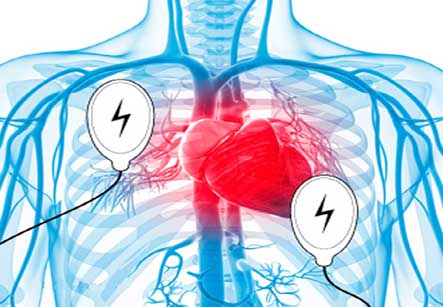Cardioversion
Introduction
Cardioversion is a medical procedure which is done to restore a normal heart rhythm for people who have certain conditions which cause abnormal heartbeats (arrhythmias). Cardioversion is most often done by sending electric stimuli or shocks to the heart through electrodes placed on the chest. Sometimes, the doctor may perform cardioversion using only medications to restore the rhythm of the heart.
Cardioversion is usually a scheduled procedure which is performed in a hospital, and the patient can usually be able to go home the same day as the procedure. For most people, cardioversion quickly restores a normal heart rhythm.
Cardioversion is usually performed by delivering controlled electric shocks to the heart, administered through electrodes attached to the chest. Intravenous sedation is usually given to the patient. Electric cardioversion takes less time than cardioversion done solely with medications. The doctor can instantly see if the procedure has restored a normal heartbeat.
If your doctor recommends cardioversion with medications to restore the heart’s rhythm, electric shocks are not administered to the heart.
Iran is among the top 10 countries in treating cardiovascular diseases, while it ranks first in the Middle East

Need for cardioversion
Cardioversion can correct a heartbeat that is too fast (tachycardia) or irregular (fibrillation). Cardioversion is usually used to treat people with atrial fibrillation or atrial flutter. These are conditions in which the electrical signals that cause the heart to beat in a regular rate and rhythm donot properly travel through the upper chambers of the heart.
Cardioversion is performed when the heart is beating ineffectively. It’s different from defibrillation, an emergency procedure performed when the heart stops abruptly or quivers uselessly. Defibrillation delivers more powerful shocks to the heart to correct its rhythm. Cardioversion is usually scheduled in advance but is sometimes also done in emergency situations.
Preparation
Cardioversion procedures are usually scheduled in advance. In some cases, if the symptoms are severe, then a cardioversion is done in an emergency setting.
The patient cannot eat or drink anything for 12 hours before the procedure. The doctor will tell you whether you should take any of your regular medications before the procedure. If medications are required to be taken before the procedure, only enough water to swallow the pills should be sipped.
If your doctor finds blood clots, your cardioversion procedure will be delayed for a few weeks while you take blood-thinning medications to reduce your risk of complications.
Before cardioversion, a procedure called as transesophageal echocardiogram is performed to check for blood clots in the heart. If these clots are dislodged by cardioversion, life-threatening complications can occur. The cardiologist decides whether a transesophageal echocardiogram is necessary before cardioversion.
In a transesophageal echocardiogram, the throat of the patient is numbed and a flexible tube containing a transducer is guided down the throat and into the esophagus (or food-pipe). From there, the transducer can obtain more-detailed images of the heart so that the doctor can check for blood clots.
If your doctor finds blood clots, your cardioversion procedure will be delayed for a few weeks while you take blood-thinning medications to reduce your risk of complications.
Post- procedure
Electric cardioversion is done on an outpatient basis, meaning you can go home the same day your procedure is done. You’ll spend about an hour in a recovery room being closely monitored for complications.
The patient is usually asleep throughout the procedure and the awareness of the surroundings may be affected for some time afterward. You will need someone to drive you home. The ability to make decisions may be affected for several hours after the procedure.
Even if no clots were found in the heart before the procedure, blood-thinning medications are needed to be taken for several weeks after the procedure to prevent new clots from forming.
Outcomes
For most people, cardioversion can quickly restore a regular heartbeat. But for some patients, the irregular heart rhythm may return within a few minutes or days. It is possible that the procedure may need to be repeated to keep a normal heart rhythm.
To keep the heart healthy, a few lifestyle changes may be required to be made. These changes are especially important to prevent or treat conditions that can cause arrhythmias, such as high blood pressure. The doctor may suggest to:
1. Avoid caffeine
2. Use less salt in diet (sodium), which can help to lower the blood pressure
3. Increase the physical activity
4. Quit smoking
5. Avoid drinking more than one drink of alcohol for women or more than two drinks for men a day, if you choose to drink at all
6. Eat heart-healthy foods
7. Maintain a healthy weight